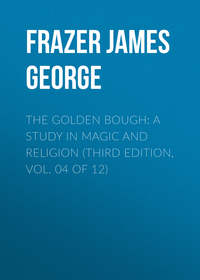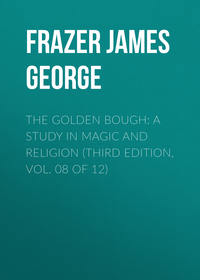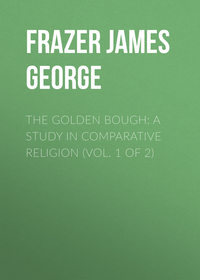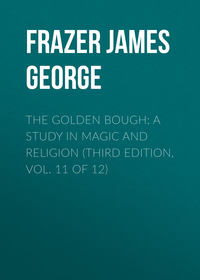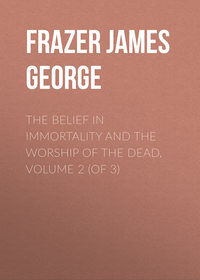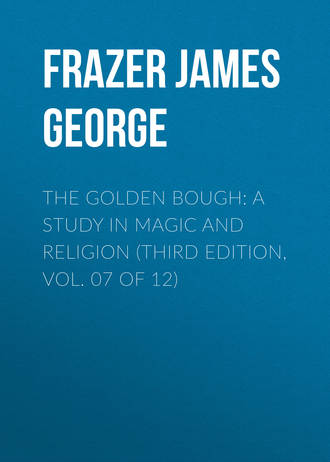 полная версия
полная версияThe Golden Bough: A Study in Magic and Religion (Third Edition, Vol. 07 of 12)
The Corn-mother in the last sheaf. Fertilising power of the Corn-mother. The Corn-mother in the last sheaf among the Slavs and in France.
Further, the Corn-mother plays an important part in harvest customs. She is believed to be present in the handful of corn which is left standing last on the field; and with the cutting of this last handful she is caught, or driven away, or killed. In the first of these cases, the last sheaf is carried joyfully home and honoured as a divine being. It is placed in the barn, and at threshing the corn-spirit appears again.429 In the Hanoverian district of Hadeln the reapers stand round the last sheaf and beat it with sticks in order to drive the Corn-mother out of it. They call to each other, “There she is! hit her! Take care she doesn't catch you!” The beating goes on till the grain is completely threshed out; then the Corn-mother is believed to be driven away.430 In the neighbourhood of Danzig the person who cuts the last ears of corn makes them into a doll, which is called the Corn-mother or the Old Woman and is brought home on the last waggon.431 In some parts of Holstein the last sheaf is dressed in woman's clothes and called the Corn-mother. It is carried home on the last waggon, and then thoroughly drenched with water. The drenching with water is doubtless a rain-charm.432 In the district of Bruck in Styria the last sheaf, called the Corn-mother, is made up into the shape of a woman by the oldest married woman in the village, of an age from fifty to fifty-five years. The finest ears are plucked out of it and made into a wreath, which, twined with flowers, is carried on her head by the prettiest girl of the village to the farmer or squire, while the Corn-mother is laid down in the barn to keep off the mice.433 In other villages of the same district the Corn-mother, at the close of harvest, is carried by two lads at the top of a pole. They march behind the girl who wears the wreath to the squire's house, and while he receives the wreath and hangs it up in the hall, the Corn-mother is placed on the top of a pile of wood, where she is the centre of the harvest supper and dance. Afterwards she is hung up in the barn and remains there till the threshing is over. The man who gives the last stroke at threshing is called the son of the Corn-mother; he is tied up in the Corn-mother, beaten, and carried through the village. The wreath is dedicated in church on the following Sunday; and on Easter Eve the grain is rubbed out of it by a seven-years-old girl and scattered amongst the young corn. At Christmas the straw of the wreath is placed in the manger to make the cattle thrive.434 Here the fertilising power of the Corn-mother is plainly brought out by scattering the seed taken from her body (for the wreath is made out of the Corn-mother) among the new corn; and her influence over animal life is indicated by placing the straw in the manger. At Westerhüsen, in Saxony, the last corn cut is made in the shape of a woman decked with ribbons and cloth. It is fastened to a pole and brought home on the last waggon. One of the people in the waggon keeps waving the pole, so that the figure moves as if alive. It is placed on the threshing-floor, and stays there till the threshing is done.435 Amongst the Slavs also the last sheaf is known as the Rye-mother, the Wheat-mother, the Oats-mother, the Barley-mother, and so on, according to the crop. In the district of Tarnow, Galicia, the wreath made out of the last stalks is called the Wheat-mother, Rye-mother, or Pea-mother. It is placed on a girl's head and kept till spring, when some of the grain is mixed with the seed-corn.436 Here again the fertilising power of the Corn-mother is indicated. In France, also, in the neighbourhood of Auxerre, the last sheaf goes by the name of the Mother of the Wheat, Mother of the Barley, Mother of the Rye, or Mother of the Oats. They leave it standing in the field till the last waggon is about to wend homewards. Then they make a puppet out of it, dress it with clothes belonging to the farmer, and adorn it with a crown and a blue or white scarf. A branch of a tree is stuck in the breast of the puppet, which is now called the Ceres. At the dance in the evening the Ceres is set in the middle of the floor, and the reaper who reaped fastest dances round it with the prettiest girl for his partner. After the dance a pyre is made. All the girls, each wearing a wreath, strip the puppet, pull it to pieces, and place it on the pyre, along with the flowers with which it was adorned. Then the girl who was the first to finish reaping sets fire to the pile, and all pray that Ceres may give a fruitful year. Here, as Mannhardt observes, the old custom has remained intact, though the name Ceres is a bit of schoolmaster's learning.437 In Upper Brittany the last sheaf is always made into human shape; but if the farmer is a married man, it is made double and consists of a little corn-puppet placed inside of a large one. This is called the Mother-sheaf. It is delivered to the farmer's wife, who unties it and gives drink-money in return.438
The Harvest-mother or the Great Mother in the last sheaf.
Sometimes the last sheaf is called, not the Corn-mother, but the Harvest-mother or the Great Mother. In the province of Osnabrück, Hanover, it is called the Harvest-mother; it is made up in female form, and then the reapers dance about with it. In some parts of Westphalia the last sheaf at the rye-harvest is made especially heavy by fastening stones in it. They bring it home on the last waggon and call it the Great Mother, though they do not fashion it into any special shape. In the district of Erfurt a very heavy sheaf, not necessarily the last, is called the Great Mother, and is carried on the last waggon to the barn, where all hands lift it down amid a fire of jokes.439
The Grandmother in the last sheaf.
Sometimes again the last sheaf is called the Grandmother, and is adorned with flowers, ribbons, and a woman's apron. In East Prussia, at the rye or wheat harvest, the reapers call out to the woman who binds the last sheaf, “You are getting the Old Grandmother.” In the neighbourhood of Magdeburg the men and women servants strive who shall get the last sheaf, called the Grandmother. Whoever gets it will be married in the next year, but his or her spouse will be old; if a girl gets it, she will marry a widower; if a man gets it, he will marry an old crone. In Silesia the Grandmother – a huge bundle made up of three or four sheaves by the person who tied the last sheaf – was formerly fashioned into a rude likeness of the human form.440 In the neighbourhood of Belfast the last sheaf sometimes goes by the name of the Granny. It is not cut in the usual way, but all the reapers throw their sickles at it and try to bring it down. It is plaited and kept till the (next?) autumn. Whoever gets it will marry in the course of the year.441
The Old Woman or the Old Man in the last sheaf.
Oftener the last sheaf is called the Old Woman or the Old Man. In Germany it is frequently shaped and dressed as a woman, and the person who cuts it or binds it is said to “get the Old Woman.”442 At Altisheim, in Swabia, when all the corn of a farm has been cut except a single strip, all the reapers stand in a row before the strip; each cuts his share rapidly, and he who gives the last cut “has the Old Woman.”443 When the sheaves are being set up in heaps, the person who gets hold of the Old Woman, which is the largest and thickest of all the sheaves, is jeered at by the rest, who call out to him, “He has the Old Woman and must keep her.”444 The woman who binds the last sheaf is sometimes herself called the Old Woman, and it is said that she will be married in the next year.445 In Neusaass, West Prussia, both the last sheaf – which is dressed up in jacket, hat, and ribbons – and the woman who binds it are called the Old Woman. Together they are brought home on the last waggon and are drenched with water.446 In various parts of North Germany the last sheaf at harvest is made up into a human effigy and called “the Old Man”; and the woman who bound it is said “to have the Old Man.”447 At Hornkampe, near Tiegenhof (West Prussia), when a man or woman lags behind the rest in binding the corn, the other reapers dress up the last sheaf in the form of a man or woman, and this figure goes by the laggard's name, as “the old Michael,” “the idle Trine.” It is brought home on the last waggon, and, as it nears the house, the bystanders call out to the laggard, “You have got the Old Woman and must keep her.”448 In Brandenburg the young folks on the harvest-field race towards a sheaf and jump over it. The last to jump over it has to carry a straw puppet, adorned with ribbons, to the farmer and deliver it to him while he recites some verses. Of the person who thus carries the puppet it is said that “he has the Old Man.” Probably the puppet is or used to be made out of the last corn cut.449 In many districts of Saxony the last sheaf used to be adorned with ribbons and set upright so as to look like a man. It was then known as “the Old Man,” and the young women brought it back in procession to the farm, singing as they went, “Now we are bringing the Old Man.”450
The Old Man or the Old Woman in the last sheaf.
In West Prussia, when the last rye is being raked together, the women and girls hurry with the work, for none of them likes to be the last and to get “the Old Man,” that is, a puppet made out of the last sheaf, which must be carried before the other reapers by the person who was the last to finish.451 In Silesia the last sheaf is called the Old Woman or the Old Man and is the theme of many jests; it is made unusually large and is sometimes weighted with a stone. At Girlachsdorf, near Reichenbach, when this heavy sheaf is lifted into the waggon, they say, “That is the Old Man whom we sought for so long.”452 Among the Germans of West Bohemia the man who cuts the last corn is said to “have the Old Man.” In former times it used to be customary to put a wreath on his head and to play all kinds of pranks with him, and at the harvest supper he was given the largest portion.453 At Wolletz in Westphalia the last sheaf at harvest is called the Old Man, and being made up into the likeness of a man and decorated with flowers it is presented to the farmer, who in return prepares a feast for the reapers. About Unna, in Westphalia, the last sheaf at harvest is made unusually large, and stones are inserted to increase its weight. It is called de greaute meaur (the Grey Mother?), and when it is brought home on the waggon water is thrown on the harvesters who accompany it.454 Among the Wends the man or woman who binds the last sheaf at wheat harvest is said to “have the Old Man.” A puppet is made out of the wheaten straw and ears in the likeness of a man and decked with flowers. The person who bound the last sheaf must carry the Old Man home, while the rest laugh and jeer at him. The puppet is hung up in the farmhouse and remains till a new Old Man is made at the next harvest.455 At the close of the harvest the Arabs of Moab bury the last sheaf in a grave in the cornfield, saying as they do so, “We are burying the Old Man,” or “The Old Man is dead.”456
Identification of the harvester with the corn-spirit.
In some of these customs, as Mannhardt has remarked, the person who is called by the same name as the last sheaf and sits beside it on the last waggon is obviously identified with it; he or she represents the corn-spirit which has been caught in the last sheaf; in other words, the corn-spirit is represented in duplicate, by a human being and by a sheaf.457 The identification of the person with the sheaf is made still clearer by the custom of wrapping up in the last sheaf the person who cuts or binds it. Thus at Hermsdorf in Silesia it used to be the regular practice to tie up in the last sheaf the woman who had bound it.458 At Weiden, in Bavaria, it is the cutter, not the binder, of the last sheaf who is tied up in it.459 Here the person wrapt up in the corn represents the corn-spirit, exactly as a person wrapt in branches or leaves represents the tree-spirit.460
The last sheaf made unusually large and heavy.
The last sheaf, designated as the Old Woman, is often distinguished from the other sheaves by its size and weight. Thus in some villages of West Prussia the Old Woman is made twice as long and thick as a common sheaf, and a stone is fastened in the middle of it. Sometimes it is made so heavy that a man can barely lift it.461 At Alt-Pillau, in Samland, eight or nine sheaves are often tied together to make the Old Woman, and the man who sets it up grumbles at its weight.462 At Itzgrund, in Saxe-Coburg, the last sheaf, called the Old Woman, is made large with the express intention of thereby securing a good crop next year.463 Thus the custom of making the last sheaf unusually large or heavy is a charm, working by sympathetic magic, to ensure a large and heavy crop at the following harvest. In Denmark also the last sheaf is made larger than the others, and is called the Old Rye-woman or the Old Barley-woman. No one likes to bind it, because whoever does so will be sure, they think, to marry an old man or an old woman. Sometimes the last wheat-sheaf, called the Old Wheat-woman, is made up in human shape, with head, arms, and legs, and being dressed in clothes is carried home on the last waggon, while the harvesters sit beside it drinking and huzzaing.464 Of the person who binds the last sheaf it is said, “She or he is the Old Rye-woman.”465
The Carlin and the Maiden in Scotland. The Old Wife (Cailleach) at harvest in the Highlands of Scotland.
In Scotland, when the last corn was cut after Hallowmas, the female figure made out of it was sometimes called the Carlin or Carline, that is, the Old Woman. But if cut before Hallowmas, it was called the Maiden; if cut after sunset, it was called the Witch, being supposed to bring bad luck.466 Among the Highlanders of Scotland the last corn cut at harvest is known either as the Old Wife (Cailleach) or as the Maiden; on the whole the former name seems to prevail in the western and the latter in the central and eastern districts. Of the Maiden we shall speak presently; here we are dealing with the Old Wife. The following general account of the custom is given by a careful and well-informed enquirer, the Rev. J. G. Campbell, minister of the remote Hebridean island of Tiree: “The Harvest Old Wife (a Chailleach). – In harvest, there was a struggle to escape from being the last done with the shearing,467 and when tillage in common existed, instances were known of a ridge being left unshorn (no person would claim it) because of it being behind the rest. The fear entertained was that of having the ‘famine of the farm’ (gort a bhaile), in the shape of an imaginary old woman (cailleach), to feed till next harvest. Much emulation and amusement arose from the fear of this old woman… The first done made a doll of some blades of corn, which was called the ‘old wife,’ and sent it to his nearest neighbour. He in turn, when ready, passed it to another still less expeditious, and the person it last remained with had ‘the old woman’ to keep for that year.”468
The Old Wife (Cailleach) in the last sheaf at harvest in the islands of Lewis and Islay. The Old Wife at harvest in Argyleshire. The reaper of the last sheaf called the Winter.
To illustrate the custom by examples, in Bernera, on the west of Lewis, the harvest rejoicing goes by the name of the Old Wife (Cailleach) from the last sheaf cut, whether in a township, farm, or croft. Where there are a number of crofts beside each other, there is always great rivalry as to who shall first finish reaping, and so have the Old Wife before his neighbours. Some people even go out on a clear night to reap their fields after their neighbours have retired to rest, in order that they may have the Old Wife first. More neighbourly habits, however, usually prevail, and as each finishes his own fields he goes to the help of another, till the whole crop is cut. The reaping is still done with the sickle. When the corn has been cut on all the crofts, the last sheaf is dressed up to look as like an old woman as possible. She wears a white cap, a dress, an apron, and a little shawl over the shoulders fastened with a sprig of heather. The apron is tucked up to form a pocket, which is stuffed with bread and cheese. A sickle, stuck in the string of the apron at the back, completes her equipment. This costume and outfit mean that the Old Wife is ready to bear a hand in the work of harvesting. At the feast which follows, the Old Wife is placed at the head of the table, and as the whisky goes round each of the company drinks to her, saying, “Here's to the one that has helped us with the harvest.” When the table has been cleared away and dancing begins, one of the lads leads out the Old Wife and dances with her; and if the night is fine the party will sometimes go out and march in a body to a considerable distance, singing harvest-songs, while one of them carries the Old Wife on his back. When the Harvest-Home is over, the Old Wife is shorn of her gear and used for ordinary purposes.469 In the island of Islay the last corn cut also goes by the name of the Old Wife (Cailleach), and when she has done her duty at harvest she is hung up on the wall and stays there till the time comes to plough the fields for the next year's crop. Then she is taken down, and on the first day when the men go to plough she is divided among them by the mistress of the house. They take her in their pockets and give her to the horses to eat when they reach the field. This is supposed to secure good luck for the next harvest, and is understood to be the proper end of the Old Wife.470 In Kintyre also the name of the Old Wife is given to the last corn cut.471 On the shores of the beautiful Loch Awe, a long sheet of water, winding among soft green hills, above which the giant Ben Cruachan towers bold and rugged on the north, the harvest custom is somewhat different. The name of the Old Wife (Cailleach) is here bestowed, not on the last corn cut, but on the reaper who is the last to finish. He bears it as a term of reproach, and is not privileged to reap the last ears left standing. On the contrary, these are cut by the reaper who was the first to finish his spagh or strip (literally “claw”), and out of them is fashioned the Maiden, which is afterwards hung up, according to one statement, “for the purpose of preventing the death of horses in spring.”472 In the north-east of Scotland “the one who took the last of the grain from the field to the stackyard was called the ‘winter.’ Each one did what could be done to avoid being the last on the field, and when there were several on the field there was a race to get off. The unfortunate ‘winter’ was the subject of a good deal of teasing, and was dressed up in all the old clothes that could be gathered about the farm, and placed on the ‘bink’ to eat his supper.”473 So in Caithness the person who cuts the last sheaf is called Winter and retains the name till the next harvest.474
The Hag (wrach) at harvest in North Pembrokeshire.
Usages of the same sort are reported from Wales. Thus in North Pembrokeshire a tuft of the last corn cut, from six to twelve inches long, is plaited and goes by the name of the Hag (wrach); and quaint old customs used to be practised with it within the memory of many persons still alive. Great was the excitement among the reapers when the last patch of standing corn was reached. All in turn threw their sickles at it, and the one who succeeded in cutting it received a jug of home-brewed ale. The Hag (wrach) was then hurriedly made and taken to a neighbouring farm, where the reapers were still busy at their work. This was generally done by the ploughman; but he had to be very careful not to be observed by his neighbours, for if they saw him coming and had the least suspicion of his errand they would soon make him retrace his steps. Creeping stealthily up behind a fence he waited till the foreman of his neighbour's reapers was just opposite him and within easy reach. Then he suddenly threw the Hag over the fence and, if possible, upon the foreman's sickle, crying out
“Boreu y codais i,Hwyr y dilynais i,Ar ei gwar hi.”The Hag (wrach) at harvest in South Pembrokeshire. The Carley at harvest in Antrim.
On that he took to his heels and made off as fast as he could run, and he was a lucky man if he escaped without being caught or cut by the flying sickles which the infuriated reapers hurled after him. In other cases the Hag was brought home to the farmhouse by one of the reapers. He did his best to bring it home dry and without being observed; but he was apt to be roughly handled by the people of the house, if they suspected his errand. Sometimes they stripped him of most of his clothes, sometimes they would drench him with water which had been carefully stored in buckets and pans for the purpose. If, however, he succeeded in bringing the Hag in dry and unobserved, the master of the house had to pay him a small fine; or sometimes a jug of beer “from the cask next to the wall,” which seems to have commonly held the best beer, would be demanded by the bearer. The Hag was then carefully hung on a nail in the hall or elsewhere and kept there all the year. The custom of bringing in the Hag (wrach) into the house and hanging it up still exists in some farms of North Pembrokeshire, but the ancient ceremonies which have just been described are now discontinued.475
Similar customs at harvest were observed in South Pembrokeshire within living memory. In that part of the country there used to be a competition between neighbouring farms to see which would finish reaping first. The foreman of the reapers planned so as to finish the reaping in a corner of the field out of sight of the people on the next farm. There, with the last handful of corn cut, he would make two Old Women or Hags (wrachs). One of them he would send by a lad or other messenger to be laid secretly in the field where the neighbours were still at work cutting their corn. The messenger would disguise himself to look like a stranger, and jumping the fence and creeping through the corn he would lay the Hag (wrach) in a place where the reapers in reaping would be sure to find it. Having done so he fled for dear life, for were the reapers to catch him they would shut him up in a dark room and not let him out till he had cleaned all the muddy boots, shoes, and clogs in the house. The second Hag (wrach) was sent or taken by the foreman of the reapers to his master's farmhouse. Generally he tried to pop into the house unseen and lay the Hag on the kitchen table; but if the people of the farm caught him before he laid it down, they used to drench him with water. If a foreman succeeded in getting both the Hags (wrachs) laid safe in their proper quarters, one at home, the other on a neighbour's farm, without interruption, it was deemed a great honour.476 In County Antrim, down to some years ago, when the sickle was finally expelled by the reaping machine, the few stalks of corn left standing last on the field were plaited together; then the reapers, blindfolded, threw their sickles at the plaited corn, and whoever happened to cut it through took it home with him and put it over his door. This bunch of corn was called the Carley477– probably the same word as Carlin.
The Old Woman (the Baba) at harvest among Slavonic peoples.
Similar customs are observed by Slavonic peoples. Thus in Poland the last sheaf is commonly called the Baba, that is, the Old Woman. “In the last sheaf,” it is said, “sits the Baba.” The sheaf itself is also called the Baba, and is sometimes composed of twelve smaller sheaves lashed together.478 In some parts of Bohemia the Baba, made out of the last sheaf, has the figure of a woman with a great straw hat. It is carried home on the last harvest-waggon and delivered, along with a garland, to the farmer by two girls. In binding the sheaves the women strive not to be last, for she who binds the last sheaf will have a child next year.479 The last sheaf is tied up with others into a large bundle, and a green branch is stuck on the top of it.480 Sometimes the harvesters call out to the woman who binds the last sheaf, “She has the Baba,” or “She is the Baba.” She has then to make a puppet, sometimes in female, sometimes in male form, out of the corn; the puppet is occasionally dressed with clothes, often with flowers and ribbons only. The cutter of the last stalks, as well as the binder of the last sheaf, was also called Baba; and a doll, called the Harvest-woman, was made out of the last sheaf and adorned with ribbons. The oldest reaper had to dance, first with this doll, and then with the farmer's wife.481 In the district of Cracow, when a man binds the last sheaf, they say, “The Grandfather is sitting in it”; when a woman binds it, they say, “The Baba is sitting in it,” and the woman herself is wrapt up in the sheaf, so that only her head projects out of it. Thus encased in the sheaf, she is carried on the last harvest-waggon to the house, where she is drenched with water by the whole family. She remains in the sheaf till the dance is over, and for a year she retains the name of Baba.482


